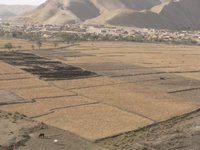Global investors are keying in on the surprising rout of the dollar in recent trading sessions. On Nov. 27, the Dow Jones Industrial Average tumbled 158.46 points, or 1.3%, in its most severe decline since July. Part of the reason (disappointing sales by Wal-Mart played a role, too) has been the dour outlook for the dollar, which could weigh down U.S. stocks for some time to come. The greenback has fallen to its lowest levels since March, 2005, when compared to a basket of major currencies.
Yet the biggest loser in any major realignment of the dollar likely will be the Europeans. It is the euro that has appreciated most dramatically against the dollar. It's up 10.9% vs. the greenback on the year. Key Asia currencies such as the yen, up 1.5% vs. the dollar this year, and the Chinese yuan (which trades in a narrow band against the U.S. and other foreign currencies) haven't moved much at all. The Korean won, up about 8.5% vs. the dollar, is the big exception.
That means European exporters are losing their price competitiveness against both U.S. and Asian rivals. And France's Finance Minister Thierry Breton on Nov. 27 urged "collective vigilance" by the European Central Bank to the alarming rise of the euro vs. the dollar to 20-month highs in recent trading sessions.
Asia: Best of Both Worlds
The ECB is expected to raise a key interest rate by a quarter of a percentage point next week because of inflation worries driven by the improving economic performance in the euro zone. By contrast, the Bank of Japan's key interest rate is all of 0.25% while the U.S. has left the closely watched Fed Fund rate of 5.25% untouched over the last three months. It isn't likely to move to raise rates as long as the housing slump is depressing growth in the U.S., so the euro looks like the most likely candidate to appreciate going forward.
Asia, meanwhile, is far more dependent on export growth and more likely to manage its currencies to maintain price competitiveness for its big export sector. In fact, the region by and large is pretty much enjoying the best of both worlds. The euro is trading at record high levels against the Japanese yen and the yuan is widely decried in Europe as being grossly undervalued.
As a result, big Japanese automakers such as Toyota (TM), Honda (HMC), and Nissan (NSANY) are enjoying robust sales and market-share gains in both regions. Chinese low-end exports such as textiles and toys, plus higher-end stuff like consumer electronics, are also streaming into the U.S. and Europe.
No End in Sight
Of course, a sharp and sustained crash in the dollar would be bad news for the entire world economy. When asked about big risks out there for the global economy, during a recent interview with BusinessWeek editors (see BusinessWeek.com, 11/3/06, "Paul Volcker Talks Trade at BW CEO Forum"), former U.S. Federal Reserve Chairman Paul Volcker asked, "suppose there is a crack in the dollar?"
The U.S. stock market likely would sustain severe wounds and the planet's biggest economy might even fall into recession. Right now, though, few economists are predicting economic Armageddon.
The U.S. would actually welcome an orderly dollar correction, given the country's gargantuan current-account deficit, the broadest measure of U.S. trade in goods and services. It clocked $431 billion in the first half of 2006, a figure that represents about 6.6% of U.S. gross domestic product and that isn't considered sustainable.
Dollar's Advantage
A gradual decline of the dollar would make exports—from Microsoft (MSFT) software to GM (GM) Cadillacs—more competitive in international markets, and likely wouldn't cause the U.S. economy too much grief. One big advantage of the dollar's status as the dominant international currency is that U.S. companies don't have to worry about currency risk since debt is raised in greenbacks and most major commodities transactions, such as oil, are in dollars.
Also, both Japan and South Korea have a track record of intervening heavily in global currency markets to prevent the yen and the won from appreciating too dramatically against the dollar. And Chinese financial authorities don't seem to be in a huge hurry to let the yuan float more freely against the dollar and other international currencies.
All this suggests that the Europeans could carry the burden of the current dollar adjustment. It's not a terribly fair deal, but seems the state of play for the moment.
Brian Bremner is BusinessWeek's Asia Regional Editor based in Hong Kong.



















